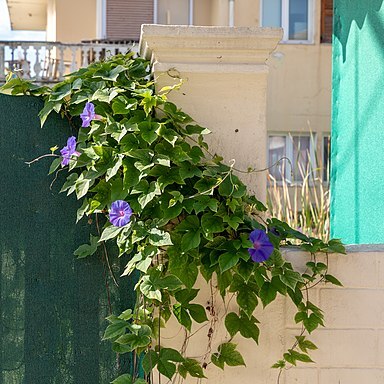A glabrous or sometimes sparsely hairy littoral plant. Stems prostrate and rooting (always?), or twining, thin, slender, herbaceous, or becoming woody with age. Leaves membranaceous or often thicker, broadly ovate to oblong in outline, occasionally orbicular to kidney-shaped, variable in size, 1-10 by 1-7½ cm; margin entire or slightly undulate to angular, or more or less deeply 3-lobed; apex acute, obtusish, obtuse or retuse, mucronu-late; base cordate, basal lobes rounded, or occasionally lobed; upper and lower surface of leaf-blade glabrous or nearly so; petiole thin, ½-7 cm. Inflorescences axillary; peduncles mostly short, 1—3(—9) cm, glabrous, one-to few-flowered. Pedicels mostly longer than the calyx, 10-25(-40) mm long, glabrous. Bracts minute, narrow, 1-2 mm long, caducous. Outer sepals shorter than the inner ones, oblong-elliptic or elliptic, acutish or obtusish, 6-10 mm long, inner ones elliptic to orbicular, 8-12 mm, all mucronulate with the mucro at the top or somewhat lower, all glabrous and concave; outer sepals thinly coriaceous, inner ones thinner with membranous margins. Corolla funnel-shaped, 3-4½ cm long, with the rather narrow tube gradually narrowed towards the base, glabrous, pink or pink purple, often darker near the base inside. Stamens and style included; filaments glabrous in the upper, and hairy in the lower half. Ovary glabrous. Capsule depressed-globose, crowned by the style-base, ca 9 mm diam., 2-celled. Seeds 4, glabrous, black, ca 3½-4 mm long.
More
Herbs perennial. Stems prostrate, rooting at nodes, or twining, slender, mostly glabrous. Petiole 0.5-7 cm; leaf blade ovate to oblong, occasionally circular or reniform, 1-10 X 1-7.5 cm, glabrous or nearly so, base cordate, margin entire or minutely undulate to angular, or ± 3-lobed, apex acute, obtuse or emarginate, mucronulate. Inflorescences usually 1-(less often few) flowered; peduncle 0.1-3 cm; bracts early deciduous, 1-2 mm. Pedicel 1-4 cm, glabrous. Sepals unequal, glabrous; outer 2 concave, oblong-elliptic, 6-10 mm, apex acute to obtuse; inner 3 elliptic to nearly circular, 0.8-1.2 cm. Corolla pink or pink-purple, with a darker center, funnelform, 3-4.5 cm, glabrous. Stamens included; filaments unequal, glandular pubescent on basal 1/2. Pistil included; ovary glabrous. Stigma 2-lobed. Capsule depressed-globose, ca. 9 mm in diam. Seeds black, ovoid, 3.5-4 mm, glabrous. 2n = 30, 60.
A trailing or climbing plant. It lies along the ground or climbs 1.5 m high. It spreads 1-3 m wide. The stems root at the nodes. The rootstock is woody. Young growth is bright green. The leaves are 1-10 cm long by 1-7.5 cm wide. They are broadly oblong. They can have 3 lobes. The leaf stalks are 9 cm long. The leaves are bright green and fleshy. The flowers are 4 cm across and pink with a darker centre. The flowers occur singly in the axils of leaves. The fruit are capsules 1 cm across.


